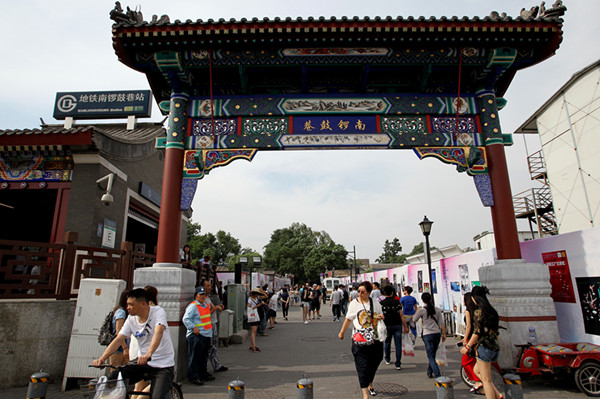 |
|
The opening of a subway station at the end of 2012 brings more people to the narrow hutong.[Photo by Zhang Wei/ China Daily] |
"New shops were springing up all over the place, and business was soaring, in terms of the number of visitors, sales and revenue," Xu says.
Inevitably though, rising demand for commercial space in the area led to soaring rents.
The average rent was about 2 yuan a day (30 cents) per square meter, but these days it is more than dozens of times that, he says.
"When rents were low you could do whatever you wanted without the slightest pressure. But as rents rose people started to cut corners to make a fast buck, for example by selling snack food, and there were those who used low-grade ingredients.
"It was like bad money driving out good money, because some of the arts and crafts stores and bars closed, as they couldn't afford the rent."
Dominic Johnson-Hill, an Englishman who sold souvenir Beijing T-shirts, says people started selling cheap snacks such as kebabs and stinky tofu on the street from about 2010. The authorities have closed many of the unlicensed ones in recent years.
"That meant it turned from a creative street into a food street-unpleasant and noisy at that time," Johnson-Hill says.
Johnson-Hill had moved to Nanluoguxiang with his family in 2003, and in 2006 founded his Plastered 8 store there.
The opening of a subway station at the end of 2012 proved to be another turning point, he says, drawing more people to the narrow hutong and driving rents up even more.
Non-Chinese are attracted to secluded places, he says, and when they become more and more crowded, they go somewhere else. In fact some of his regular customers started buying his T-shirts online because they did not want to jostle through crowds at Nanluoguxiang, he says.
Wang Haiyan, who with her husband opened a bar called Passby in 1999, says that before 2008 many of their customers were regulars, many of whom loved literature and art, but now most are tourists. In the early days about 70 percent of customers were Europeans but now only about 30 percent are non-Chinese, she says.
She hopes that as fewer people come, those who want to make easy money will be squeezed out of the market, rents will return to what she considers a reasonable level and creative types will be drawn back to the area.
"It's like restoring an ecosystem. It's anyone's guess about how long it will take, but I am confident things will come right if we do the right thing and persist with it."
Apart from tourists who may pay a quick visit, there are those keen on taking a look at the way of life in hutong. Wang, who reveals only her surname, says she is interested in architecture and rents a bicycle so she can do a tour of Nanluoguxiang's ancient residences and chat with the locals.
More than 30 ancient residences of well-known people such as nobility and cabinet ministers, before and during the early 20th century, such as China's last empress Wanrong, are well marked. Only three are open to visitors, the rest being mainly vacant, stately or privately owned.
Xu says there are plans to develop comprehensive tourist products that take in surrounding cultural sites in the alleys.
Liu Simin, vice-president of the tourism branch of the Chinese Society for Futures Studies, says it is inappropriate to develop a residential hutong into a commercial street because it will gradually lose its essence-culture.
"Many well-known people used to live here. It represents Beijing's typical hutong culture, and you can see the local residents' lifestyle. It is culture first and foremost that draws tourists here."
Liu acknowledges that early on what really attracted many people to Nanluoguxiang were its cafes, bars and arts and crafts stores. Many of those who visited nearby Houhai gradually shifted their attention to Nanluoguxiang, and similar stores opened.
"Many Chinese prefer a blend of Chinese and Western because they want to enjoy the leisurely lifestyle the West offers. In one sense you can see that as creative, but you see it spreading all over the country."
The famous cafes along the Seine in Paris are scattered rather than squeezed into a narrow alley, he says, and Parisians are proud of their cafe culture and would not open a teahouse there just because many Chinese travelers visit the place.
"They emphasize the uniqueness of their culture, but we focus on a mixed culture. Businesses strive to cater to customers' needs, so cafes in a hutong have styles that reflect the whole world."
It is important to restore buildings to reflect earlier lifestyles, he says, and to open to the public more residences that were owned or occupied by notable people or establish hostels that focus on Beijing culture.
"If things don't change it will be driven out of the market sooner or later, because commercial patterns simply replicate themselves in other places."
|
|
|
|
|
|
|
|
